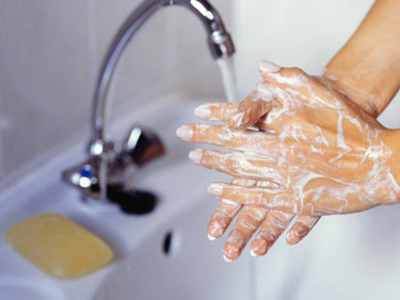by Renée Canada
You can hardly go anywhere public these days without seeing hand sanitizers in every corner. They are at the entrance of your local grocery store. They are in museums. Of course, they are on every floor and wing of hospitals. It becomes almost like an addiction: even when you know your hands are clean, if you see that familiar Purell dispenser, you have to get your fix, squirt and rub those germs away. But are these hand sanitizers really doing anything to keep you healthy?
According to a recent study reported on Consumerist.com, researchers found that alcohol-based sanitizers are no better at preventing colds and flu than washing your hands with ordinary soap. A University of Virginia study found that there was only a 9 percent difference in the rate of common cold infections between those using sanitizers and those who didn’t take any precautions at all. For the flu, there was only a 3 percent difference.
Only a few months ago the FDA claimed that antibacterial soaps containing Triclosan might be just as effective as regular soap. The FDA also went further by posting a document of things you should know about the antibacterial, also used in some toothpastes, which was first used as a pesticide in 1969. While it is not presently known to be dangerous to humans, it has been shown to alter hormone regulation in animals. More concerning to us, perhaps, is that other studies in bacteria have raised concerns that triclosan contributes to making bacteria resistant to antibiotics.
 It is troublesome to hear that while we’re so eager to squirt our hands with this stuff with the aim to fight germs, we might be in fact contributing to making our bodies more resistant to medicines that help us to fight off bacteria when we do get sick. So what fuels the obsession with using hand sanitizers? Is it just a placebo to make us feel like we’re doing something to protect our health?
It is troublesome to hear that while we’re so eager to squirt our hands with this stuff with the aim to fight germs, we might be in fact contributing to making our bodies more resistant to medicines that help us to fight off bacteria when we do get sick. So what fuels the obsession with using hand sanitizers? Is it just a placebo to make us feel like we’re doing something to protect our health?
While Purell kills cold viruses in the lab, other factors affect its efficacy in the real world. With children touching their nose or mouth every three minutes, and people averaging contact with 30 different objects per minute, it’s impossible to stay on top of the spread of cold viruses, which are spread mostly through hand contact. Flu viruses are mostly spread through air droplets, making hand sanitizers ineffective for prevention.
 Yet it is without question that hand-washing in medical settings has been proven to save lives. When coupled with surgical draping and universal gloving, it reduces the rate of life-threatening infections during surgery and intensive care unit stays. Additionally, the UVA’s team research leader did point to studies that indicated the effectiveness of sanitizers on cutting down on gastrointestinal diseases. However, even in hospitals where hand-washing rates jumped 30 percent, there was no overall reduction in infection rates.
Yet it is without question that hand-washing in medical settings has been proven to save lives. When coupled with surgical draping and universal gloving, it reduces the rate of life-threatening infections during surgery and intensive care unit stays. Additionally, the UVA’s team research leader did point to studies that indicated the effectiveness of sanitizers on cutting down on gastrointestinal diseases. However, even in hospitals where hand-washing rates jumped 30 percent, there was no overall reduction in infection rates.
There is something positive to be said for the placebo effect of hand sanitizers however. I’m sure I’m not the only one who has gone to public bathrooms in every possible setting and seen people leave the room without washing their hands. Some of those same people will see the Purell dispenser at the entrance to Big Y and use it to scrub their grubby little hands before touching the grocery cart. And I will be eternally grateful that if I use the cart after them, whatever germs they left or picked up in the bathroom might be cleansed from their hands at least.
@2010

Thanks for writing about hand cleaning. So important to get the soap and water going